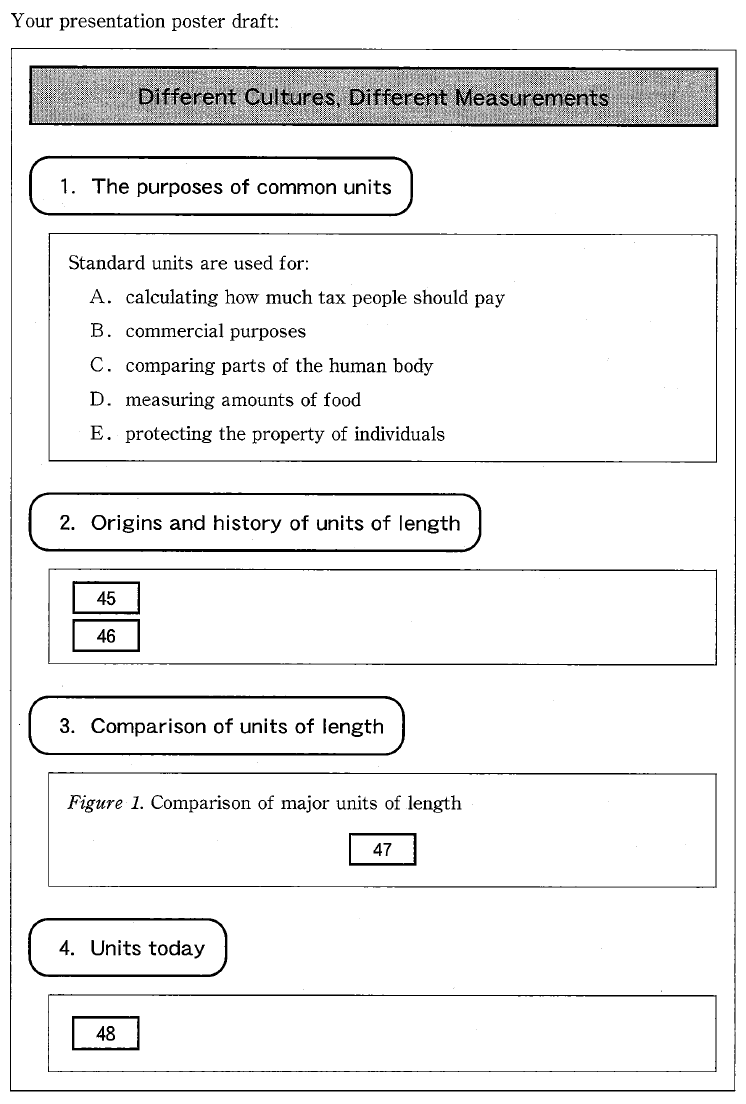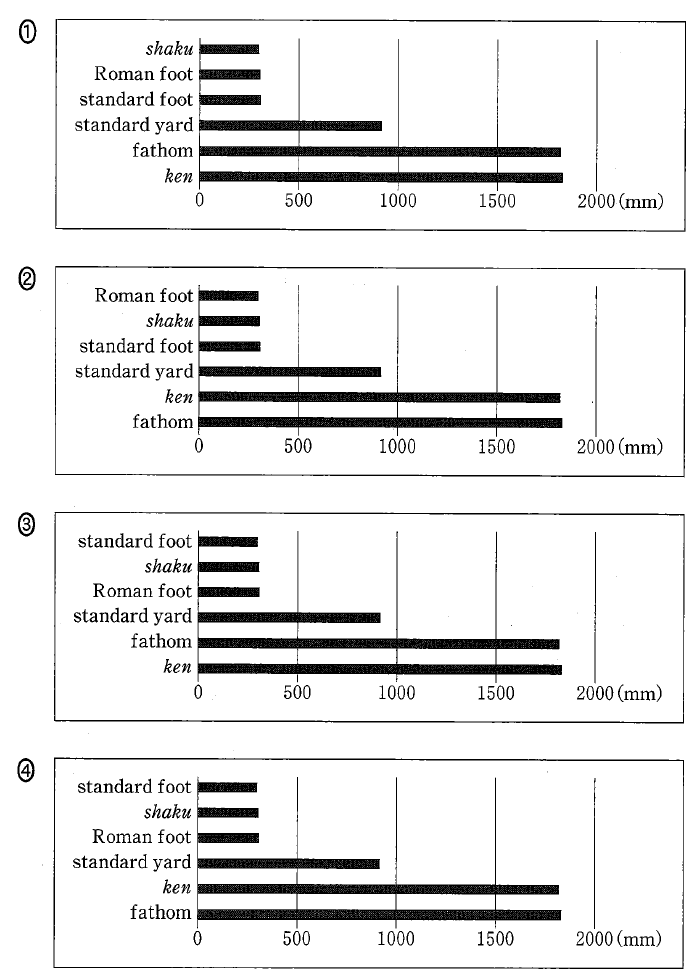2022年度の大学入学共通テスト追試験英語第6問Bの解説をしています。疑問点が残らないよう、解き方の手順も踏まえて一問一問どこよりも丁寧に説明します。
問題
You are in a student group preparing a poster for a presentation contest. You have been using the following passage to create the poster.
A Brief History of Using of Length
Since ancient times, people have measured things. Measuring helps humans say how long, far, big, or heavy something is with some kind of accuracy. While weight and volume are important for the exchange of food, it can be argued that one of the most useful measurements is length because it is needed to calculate area, which helps in the exchange, protection, and taxation of property.
Measuring systems would often be based on or related to the human body. One of the earliest known measuring systems was the cubit, which was created around the 3rd millennium BC in Egypt and Mesopotamia. One cubit was the length of a man’s forearm from the elbow to the tip of the middle finger, which according to one royal standard was 524 millimeters (mm). In addition, the old Roman foot (296 mm), which probably came from the Egyptians, was based on a human foot.
A unit of measurement known as the yard probably originated in Britain after the Roman occupation and it is said to be based on the double cubit. Whatever its origin, there were several different yards in use in Britain. Each one was a different length until the 12th century when the yard was standardized as the length from King Henry Ⅰ’s nose to his thumb on his outstretched arm. But it was not until the 14th century that official documents described the yard as being divided into three equal parts ─ three feet ─ with one foot consisting of 12 inches. While this description helped standardize the inch and foot, it wasn’t until the late 15th century, when King Henry Ⅶ distributed official metal samples of feet and yards, that people knew for certain their true length. Over the years, a number of small adjustments were made until the International Yard and Pound Agreement of 1959 finally defined the standard inch, foot, and yard as 25.4 mm, 304.8 mm, and 914.4 mm respectively.
The use of the human body as a standard from which to develop a measuring system was not unique to western cultures. The traditional Chinese unit of length called chi ─ now one-third of a meter ─ was originally defined as the length from the tip of the thumb to the outstretched tip of the middle finger, which was around 200 mm. However, over the years it increased in length and became known as the Chinese foot. Interestingly, the Japanese shaku, which was based on the chi, is almost the same as one standard foot. It is only 1.8 mm shorter.
The connection between the human body and measurement can also be found in sailing. The fathom (6 feet), the best-known unit for measuring the depth of the sea in the English-speaking world, was historically an ancient Greek measurement. It was not a very accurate measurement as it was based on the length of rope a sailor could extend from open arm to open arm. Like many other British and American units, it was also standardized in 1959.
The metric system, first described in 1668 and officially adopted by the French government in 1799, has now become the dominant measuring system worldwide. This system has slowly been adopted by many countries as either their standard measuring system or as an alternative to their traditional system. While the metric system is mainly used by the scientific, medical, and industrial professions, traditional commercial activities still continue to use local traditional measuring systems. For example, in Japan, window widths are measured in ken (6 shaku).
Once, an understanding of the relationship between different measures was only something traders and tax officials needed to know. However, now that international online shopping has spread around the world, we all need to know a little about other countries’ measuring systems so that we know how much, or how little, of something we are buying.

問1 When you were checking the statements under the first poster heading, everyone in the group agreed that one suggestion did not fit well. Which of the following should you not include? ( 44 )
- A
- B
- C
- D
- E
問2 Under the second poster heading, you need to write statements concerning units of length. Choose the two below which are most accurate. (The order does not matter) ( 45 )・( 46 )
- Inch and meter were defined by the 1959 International Yard and Pound Agreement.
- The chi began as a unit related to a hand and gradually became longer over time.
- The cubit is one of the oldest units based on the length of a man’s foot.
- The length of current standard yard was standardized by King Henry Ⅶ.
- The origin of the fathom was from the distance between a man’s open arms.
- The origin of the Roman foot can be traced back to Great Britain.
問3 Under the third poster heading, you want a graphic to visualize some of the units in the passage. Which graph best represents the different length of the units from short (as the top) to long (at the bottom)? ( 47 )

問4 Under the last poster heading, your group wants to add a statement about today’s units based on the passage. Which of the following is the most appropriate? ( 48 )
- Although the metric system has become dominant worldwide, traditional measuring systems continue to play certain roles in local affairs.
- Science and medicine use traditional units today to maintain consistency despite the acceptance of a widespread standardized measurement system.
- The increase in cross-border online shopping has made the metric system the world standard.
- Today’s units, such as the inch, foot, and yard, are based on the chi, whose origin is related to a part of the human body.
解説 問1
When you were checking the statements under the first poster heading, everyone in the group agreed that one suggestion did not fit well. Which of the following should you not include?
最初のポスターの見出しの下にある記述を確認したとき、グループの全員が1つの提案がうまく適合しないことに同意しました。次のうち、含めてはいけないものはどれですか?
最初の見出しは The purpose of common units です。そこにはこのように書かれてあります。
Standard units are used for: / 基準の単位は~に使われる
A. calculating how much tax people should pay / 人々が支払うべき税金の計算
B. commercial purposes / 商業目的
C. comparing parts of the human body / 人体の部分を比較する
D. measuring amounts of food / 食物の量を測定する
E. protecting the property of individuals / 個人の財産を保護する
このA~Eのうち一ついらないものがあるんですね。それを選ぶ問題です。
第一段落にこうあります。
While weight and volume are important for the exchange of food
食品の交換には重量と体積が重要ですが…
「食物の量を測定する」ので、「D」は必要です。
さらに第一段落にはこうあります。
which helps in the exchange, protection, and taxation of property.
それは資産の交換、保護、課税に役立ちます
「税金の計算」「財産の保護」で使うので、「A」と「E」は必要です。
第六段落の最後にこうあります。
traditional commercial activities still continue to use local traditional measuring systems.
伝統的な商業活動は依然として地元の伝統的な測定システムを使用しています
「商業目的」で使用しますので、「B」は必要です。
ということで、「人体の部分を比較する」のには使っていませんので、「C」は必要ありません。正解は「3」です。

「人体の部分」が単位のもとにもとになっています。ですが、それは「人体の部分」を比較するためではありませんね。
解説 問2
Under the second poster heading, you need to write statements concerning units of length. Choose the two below which are most accurate. (The order does not matter)
2番目のポスターの見出しの下に、長さの単位に関して記述する必要があります。最も正確なものを以下の2つから選択してください。 (順序は関係ありません)
選択肢はこうです。
1. Inch and meter were defined by the 1959 International Yard and Pound Agreement.
インチとメートルは、1959年の国際ヤードポンド協定によって定義されました。
International Yard and Pound Agreement に関しては、第三段落にこうあります。
the International Yard and Pound Agreement of 1959 finally defined the standard inch, foot, and yard as 25.4 mm, 304.8 mm, and 914.4 mm respectively.
1959年の国際ヤードポンド協定で、最終的に標準のインチ、フィート、ヤードがそれぞれ25.4 mm、304.8 mm、914.4mmと定義されました。
「インチ」は確かに International Yard and Pound Agreement によって定義されました。しかし「メートル」はそこで定義されていません。この選択肢は違います。
2. The chi began as a unit related to a hand and gradually became longer over time.
chi は手に関連する単位として始まり、時間の経過とともに徐々に長くなりました。
chi に関しては、第四段落にこうあります。
The traditional Chinese unit of length called chi ─ now one-third of a meter ─ was originally defined as the length from the tip of the thumb to the outstretched tip of the middle finger, which was around 200 mm. However, over the years it increased in length and became known as the Chinese foot.
chi と呼ばれる伝統的な中国の長さの単位(現在は3分の1メートル)は、もともと親指の先から中指の伸ばした先までの長さとして定義されていました。これは約200mmでした。しかし、年月を経て長さが増し、Chinese foot として知られるようになりました。
「手」に関する単位で、年月とともに長くなっています。この選択肢が正解です。
3. The cubit is one of the oldest units based on the length of a man’s foot.
cubit は、男性の足の長さに基づく最も古い単位の1つです。
cubit に関しては、第二段落にこうあります。
One cubit was the length of a man’s forearm from the elbow to the tip of the middle finger, which according to one royal standard was 524 millimeters (mm).
1 cubit は、肘から中指の先端までの男性の前腕の長さであり、1つの王室旗によると524ミリメートル(mm)でした。
cubit は「腕」に基づく単位です。「足」に基づくものではありません。この選択肢は違います。
4. The length of current standard yard was standardized by King Henry Ⅶ.
現在の標準ヤードの長さは、ヘンリー七世によって標準化されました。
ヘンリー七世に関しては、第三段落にこうあります。
the late 15th century, when KIng Henry Ⅶ distributed official metal samples of feet and yards, that people knew for certain their true length. Over the years, a number of small adjustments were made
15世紀後半に、ヘンリー7世がフィートとヤードの公式の金属サンプルを配布したとき、人々はそれらの本当の長さを確実に知りました。何年にもわたっていくつかの小さな調整が行われました。
ヘンリー七世はヤードを標準化しました。しかし、それは「現在」のヤードではありません。そこから何度が調整がされています。この選択肢は違います。
5. The origin of the fathom was from the distance between a man’s open arms.
fathom の起源は、男性の両手を広げた距離からでした。
fathom に関しては、第五段落にこうあります。
It was not a very accurate measurement as it was based on the length of rope a sailor could extend from open arm to open arm.
船員が開いた腕から開いた腕まで伸ばすことができるロープの長さに基づいていたので、それはあまり正確な測定ではありませんでした。
between a man’s open arms と from open arm to open arm が対応しています。この選択肢が正解です。
6. The origin of the Roman foot can be traced back to Great Britain.
Roman foot の起源はイギリスにまでさかのぼることができます。
Roman foot に関しては、第二段落にこうあります。
In addition, the old Roman foot (296 mm), which probably came from the Egyptians, was based on a human foot.
さらに、おそらくエジプト人から来た古代の Roman foot(296 mm)は、人間の足に基づいていました。
Roman foot の由来は「イギリス」ではなく、「エジプト」です。この選択肢は違います。
ということで、正解は「2」と「5」です。

本文に出てくる順番もバラバラだし、広範囲にわたっていますので、該当部分を探すのが大変です。本文を読むときに「単位」に印をするなど、後で確認しやすいように工夫をしておくといいですね。
解説 問3
Under the third poster heading, you want a graphic to visualize some of the units in the passage. Which graph best represents the different length of the units from short (as the top) to long (at the bottom)?
3番目のポスターの見出しの下に、文章中の単位の一部を視覚化するグラフィックが必要です。短い(上部)から長い(下部)までの単位の長さの違いを最もよく表すグラフはどれですか?
単位の長さ比べです。本文中に出てくる長さの単位を確認しましょう。
まず第二段落に Roman foot が出てきます。
the old Roman foot (296 mm),
Roman foot は 296 mm です。
standard foot と standard yard は、第三段落に出てきます。
the International Yard and Pound Agreement of 1959 finally defined the standard inch, foot, and yard as 25.4 mm, 304.8 mm, and 914.4 mm respectively.
1959 年の国際ヤード ポンド協定で、最終的に標準のインチ、フィート、およびヤードがそれぞれ 25.4 mm、304.8 mm、および 914.4 mm と定義されました。
standard foot は 304.8 mm で、standard yard は 914.4 mm です。
shaku は第四段落に出てきます。
Interestingly, the Japanese shaku, which was based on the chi, is almost the same as one standard foot. It is only 1.8 mm shorter.
興味深いことに、chi を基にした日本の shaku は、standard foot とほぼ同じです。わずか1.8mm短いだけです。
shaku は satndard foot より 1.8 mm 短いのですから、「304.8-1.8=303」です。shaku は 303 mm です。
fathom は第五段落に出てきます。
The fathom (6 feet)
fathom は 6 feet ですから、「304.8×6=1828.8」です。fathom は 1828.8 mm です。
ken は第六段落に出てきます。
For example, in Japan, window widths are measured in ken (6 shaku).
たとえば、日本では、窓の幅は ken(6尺)で測定されます。
ken は 6 shaku ですから、「303×6=1818」です。shaku は 1818 mm です。
以上を踏まえて「長さの単位」を順番に並べると、こうなります。
Roman foot (296 mm) < shaku (303 mm) < standard foot (304.8 mm) < standard yard (914.4 mm) < ken (1818 mm) < fathom (1828.8 mm)
ということで、正解は「2」です。

グラフを見るだけでは、下位の三つの大小、上位の二つの大小の区別がつきません。見た目で差はほとんどありませんが、短いものから長いものに並べられていることに注意です。本文に数字が出てきたら、表へメモしておくといいですね。
解説 問4
Under the last poster heading, your group wants to add a statement about today’s units based on the passage. Which of the following is the most appropriate?
ポスターの最後の見出しの下に、あなたのグループは、文章に基づいて現在の単位についての記述を追加したいと考えています。次のうちどれが最も適切ですか?
選択肢を確認しましょう。
1. Although the metric system has become dominant worldwide, traditional measuring systems continue to play certain roles in local affairs.
メートル法は世界で支配的になっていますが、従来の測定システムは引き続き地域の事柄では一定の役割を果たしています。
メートル法に関しては、第六段落にこうあります。
While the metric system is mainly used by the scientific, medical, and industrial professions, traditional commercial activities still continue to use local traditional measuring systems.
メートル法は主に科学、医療、および産業の専門家によって使用されていますが、伝統的な商業活動は依然として地元の伝統的な測定システムを使用しています。
選択肢の内容と一致しています。この選択肢が正解です。
2. Science and medicine use traditional units today to maintain consistency destite the acceptance of a widespread standardized measurement system.
広く標準化された測定システムが受け入れられているにもかかわらず、科学と医療は現在、一貫性を維持するために従来の単位を使用しています。
選択肢「1」で確認したとおり、科学や医療分野では、「従来」の単位ではなく、メートル法を使っています。この選択肢は違います。
3. The increase in cross-border online shopping has made the metric system the world standard.
国境を越えたオンラインショッピングの増加により、メートル法は世界標準になりました。
オンラインショッピングに関しては、第七段落にこうあります。
However, now that international online shopping has spread around the world, we all need to know a little about other countries’ measuring systems so that we know how much, or how little, of something we are buying.
しかし、国際的なオンラインショッピングが世界中に広がった今、私たち全員が他の国の測定システムについて少し知って、購入しているものがどれくらい多いのか、または少ないのかを知る必要があります。
オンラインショッピングが広がったので、他の国の単位を知っておく必要があると言っています。ということは、オンラインショッピングの増加とメートル法は関係ありません。この選択肢は違います。
4. Today’s units, such as the inch, foot, and yard, are based on the chi, whose origin is related to a part of the human body.
インチ、フィート、ヤードなどの現在の単位は、人体の一部に由来する chi に基づいています。
ヤードに関しては、第三段落にこうあります。
A unit of measurement known as the yard probably originated in Britain after the Roman occupation and it is said to be based on the double cubit.
ヤードと呼ばれる測定単位は、おそらくローマの占領後にイギリスで生まれたものであり、2キュビットに基づいていると言われています。
ヤードは chi ではなく、cubit に基づいています。そしてフィートとインチに関しては、こうあります。
But it was not until the 14th century that official documents described the yard as being divided into three equal parts ─ three feet ─ with one foot consisting of 12 inches.
しかし、公式文書がヤードを3つの等しい部分(3フィート)に分割し、1フィートが12インチであると説明したのは14世紀になってからでした。
It was not until ~ that … の形です。「~して初めて…した」の意味になる、強調構文ですね。細かい意味は置いておいて、フィートとインチがヤードに関係していることがわかればいいです。
フィートとインチはヤードに基づいています。ヤードが chi に基づいていますので、フィートもインチも chi に基づいていると言えます。
つまりインチ、フィート、ヤードは全て chi に基づいていませんので、この選択肢は違います。
ということで、正解は「1」です。

問題の流れ的に第六段落、第七段落を読んで解答すればよいと考えられます。ですが、それで判断ができないこともあるでしょう。その時は、選択肢「4」の内容は第三段落にありますので、そこも確認しなくてはなりません。この問題に関しては消去法ではなく、直接正解を選べた方が時間的によさそうです。




コメントをどうぞ
「304.8-1.8=300」です。shaku は 300 mm す。
ここ間違っております。
ご指摘ありがとうございます。
修正しました。